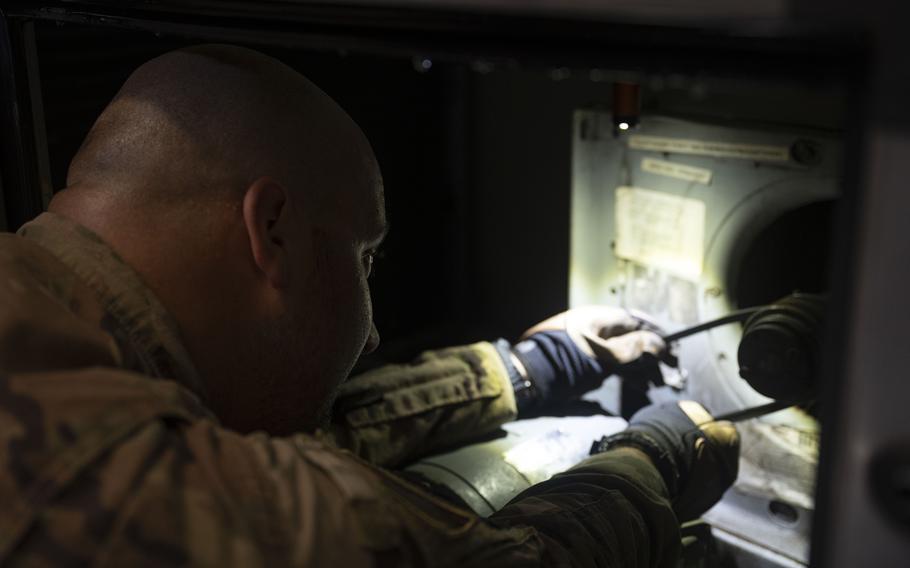
Staff Sgt. Justin Bosch of the 8th Civil Engineer Squadron replaces an air conditioning belt at Kunsan Air Base, South Korea, on Aug. 14, 2024. (Nicholas Ross/U.S. Air Force)
As temperatures soared this summer, Kunsan Air Base’s 8th Civil Engineer Squadron battled every day to keep air conditioners blowing cold air 136 miles southwest of Seoul.
Air conditioning during the torrid summers on the Korean Peninsula provides more than comfort; it’s essential to flight operations in some cases.
“During peak summer, we can get anywhere from 20 to 50 calls a week,” Staff Sgt. Nickolas Lawson, a squadron heating, ventilation and air conditioning technician, told Stars and Stripes by phone Aug. 28.
South Korea just endured its hottest summer on record, with an average temperature from June to August of 78.1 degrees Fahrenheit, nearly two degrees above the historical norm, according to the Korea Meteorological Administration.
South Korea also experienced its longest streak on record of tropical nights, defined as nighttime temperatures that remain above 77 degrees, according to The Korea Herald on Sept. 1 and the Korea Meteorological Association. Seoul logged 37 consecutive tropical nights and Jeju Island, offshore of the country’s southern tip, recorded 47.
The intense heat and humidity rapidly deteriorate the lifespan of HVAC systems, pushing the civil engineering team into overdrive with preventive maintenance and emergency repairs, Lawson said.
Compounding their challenges are frequent power outages, usually caused by summer storms that wreak havoc on the already stressed systems.
“It can happen a couple of times a month, if not more,” Tech. Sgt. Keandrae Lampley, an HVAC technician for the 8th Fighter Wing, said by phone Aug. 28. “Sometimes weather also plays a factor into that, so storms and tropical weather can affect power outages as well.”

Senior Airman Intorn Messa of the 8th Civil Engineer Squadron reviews an HVAC work order at Kunsan Air Base, South Korea, on Aug. 8, 2024. (Nicholas Ross/U.S. Air Force)
Power outages are very bad for air conditioning equipment, which must be constantly monitored to ensure it comes back online properly, Lawson said.
The team’s work is essential to keeping operations running, Lawson said.
The civil engineers recently received a 3 a.m. call to restore a cooling unit essential for a satellite link, allowing aircraft to take off as scheduled, he said.
Preventive measures are key to avoiding such crises. Units must be kept clean to ensure proper airflow, Lampley said.
Sometimes the hand-off between personnel rotating in and out of South Korea gives rise to miscommunication, he said.
“They’re picking up from where other people left off, and some people before don’t account for where they left off,” Lampley said. “There might be little communication between rotations, so maintaining it gets lost, in a sense.”
Lawson said better tools and more supplies have become available, which improves the HVAC team’s efforts significantly.
“When I first got here, we were struggling a little bit, but we were able to get a lot more in, and we’ve been a lot better on the tool side,” he said. “We’ve been able to get a lot more supplies to fix things, and we’ve been able to get the money to actually get more and more supplies for guys coming in after us.”
Extreme temperatures present a challenge for HVAC technicians in an age when many people regard air conditioning as essential.
“We don’t always have the solution right at hand, but we come up with a solution in the long run,” Lampley said. “We do what we can and try our best day in, day out.”